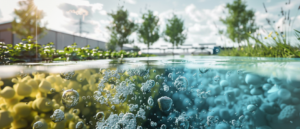 Modern water supply systems face an increasing challenge from pesticides and other micropollutants.
Modern water supply systems face an increasing challenge from pesticides and other micropollutants.
Traditional water treatment methods, such as activated carbon filtration, are not always effective against certain persistent chemicals. One promising solution is the Advanced Oxidation Process (AOP), where ozone combined with hydrogen peroxide effectively breaks down contaminants. For example, metaldehyde – a difficult-to-remove pesticide often found in surface waters. By applying ozonetogether with hydrogen peroxide, significant degradation of this compound can be achieved while reducing the risk of bromate formation.
This method ensures compliance with strict EU regulations while maintaining an efficient and cost-effective water treatment process.Experimental studies have shown that an optimal ozone dosage of 8 g/m³ combined with hydrogen peroxide concentrations of 16–22 ppm efficiently removes metaldehyde and keeps bromate levels below 3 µg/L.In conclusion, ozone-based advanced oxidation is one of the most effective solutions for tackling water
contamination, offering both environmental and economic benefits.